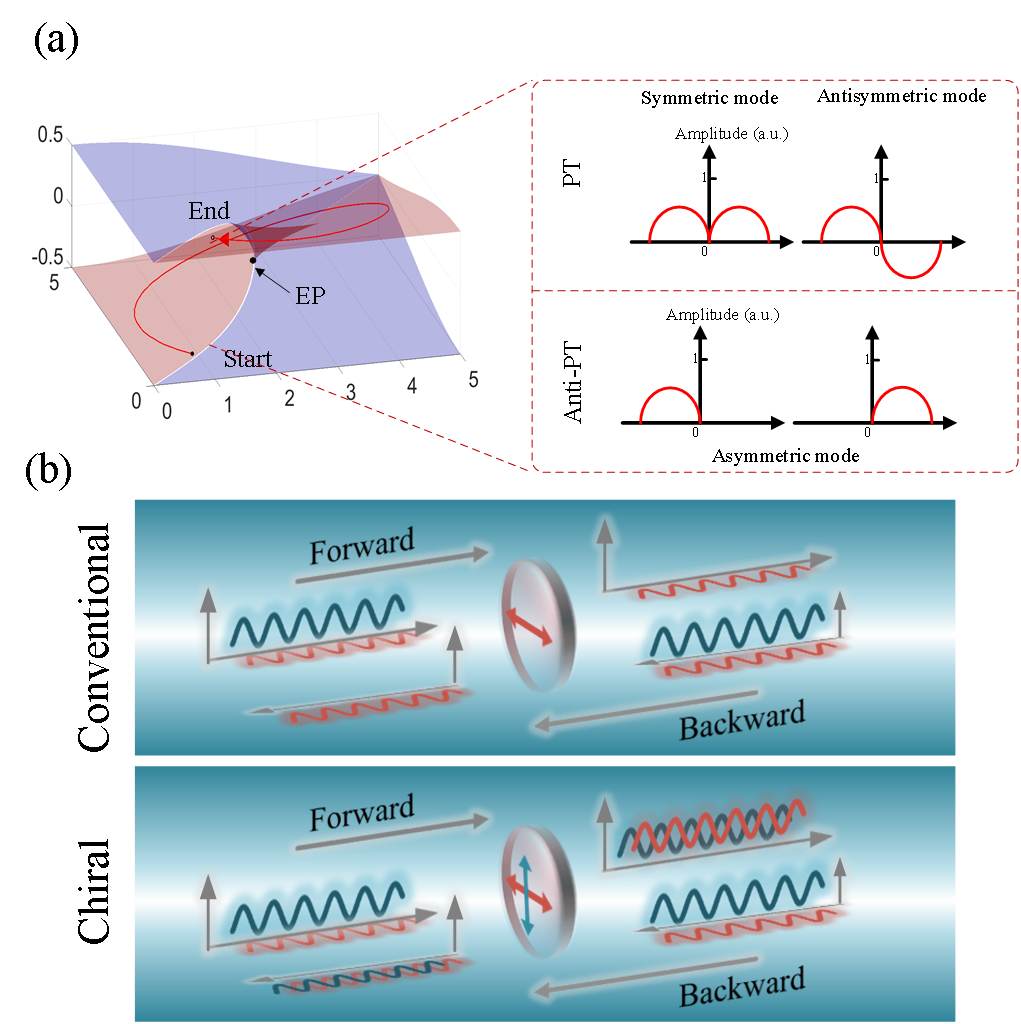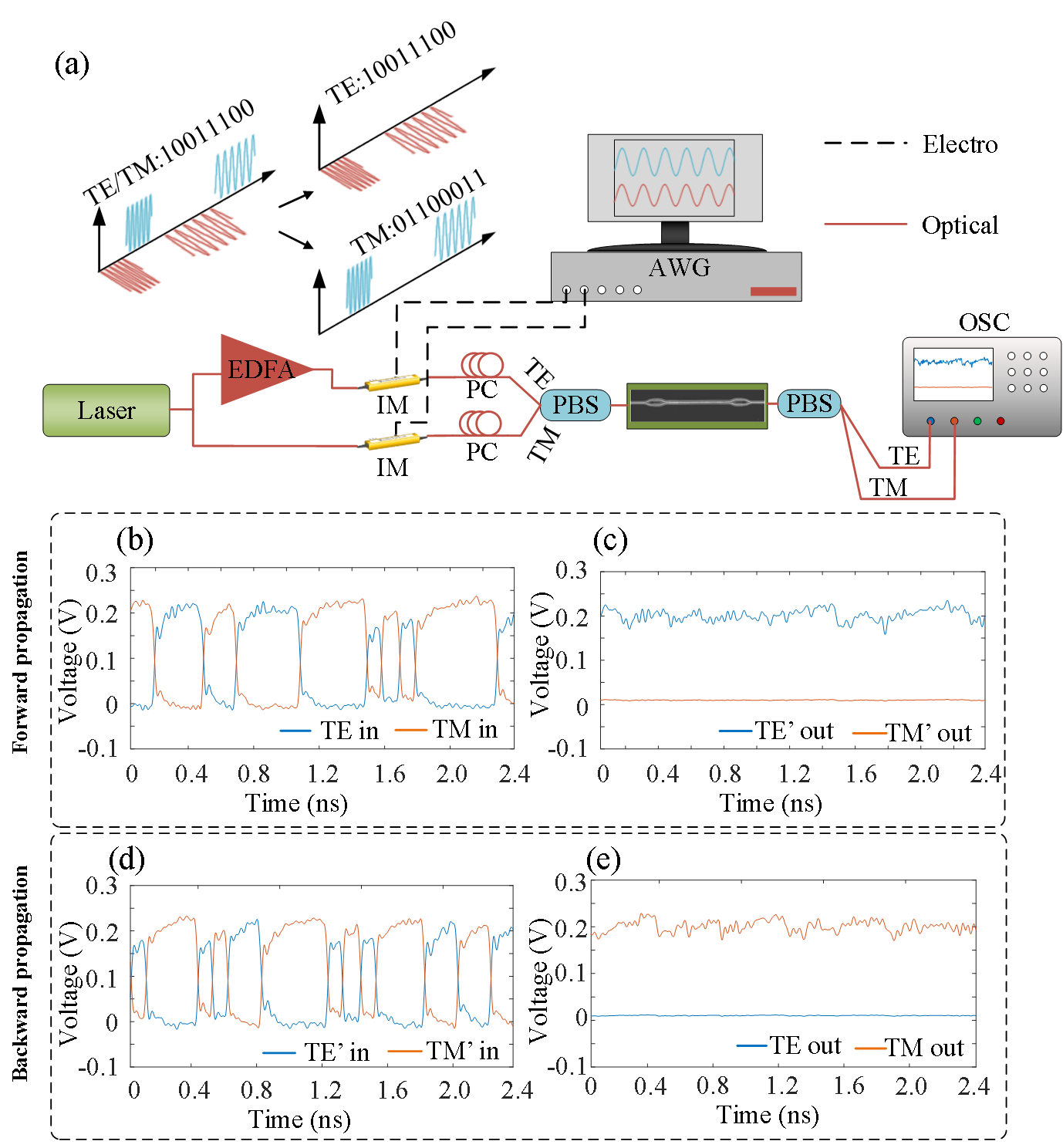Parity-time (PT) symmetry, as a potential method for enhancing the performance of photonics devices, has been applied in fields such as single mode lasing, optoelectronic oscillator, sensing and unidirectional propagation. The abundant novel properties of PT symmetry make it a hotspot which catches the eyes of many researchers.
Exceptional point (EP) is a particular point in the PT symmetric system, at which eigenvalues and eigenvectors degenerate. Plenty of counterintuitive phenomena have been observed around EP. Specially, owing to non-Hermiticity induced nonadiabatic transitions, chiral mode switching has been achieved by encircling the exceptional point (EEP) in a PT symmetric system, exhibiting great potential for chiral devices.
In a photonic system, EEP evolution can be realized by mapping the parameters of the system along the propagation direction of light, and the evolution path of the parameters will form a circling around the EP in the parametric space. Asymmetric switching can be realized between the symmetric and anti-symmetric super-modes of the system.
However, this chiral dynamic is based on the coupling of spatial mode so far, and has never been achieved on the polarization dimension. Because of the asymmetric property of polarization, it is unsuitable to perform EEP based on polarization coupling in a PT symmetric system (Fig. 1(a)). Considering the wide application of polarization, asymmetric polarization switching could play an important role in polarization manipulation.Therefore, it is worth to find a well-matched system to realize asymmetric polarization switching.
In recent years, a new concept of anti-PT symmetric system arises.As the counterpart of PT symmetry, anti-PT symmetry also demonstrates plenty of novel properties. For practical optical applications, anti-PT symmetry is usually demonstrated by indirectly dissipative coupling, nonlinear coupling and spinning the resonator etc. Especially, indirect coupling makes it a perfect system to construct chiral polarization switching (Fig. 1(a)).

Fig.1. The concept scheme of the chiral polarizer.(a) The differenceof starting mode of encircling EP inPT/anti-PTsymmetric system.(b) The difference between conventional polarizer and chiral polarizer.
Recently, the research group led by Prof. Xinliang Zhang from Wuhan National Laboratory for Optoelectronics, Huazhong University of science and technology, proposed a chiral polarizer based on encircling EP in an anti-PT symmetric system. This work was on-line published in Photonics Research on 13 December 2021.
Asymmetric polarization switching can be realized by combining the anti-PT symmetric system and polarization modes based EEP evolution. This interesting phenomenon can be applied as a chiral polarizer. As shown in Fig. 1(b), a conventional polarizer will eliminate undesired polarization component, and the polarized transmission axes will keep unchanged for bidirectional propagation. However, a chiral polarizer will rotate the cross polarization state to the transmission axis, and exhibit different transmission axes for forward and backward propagation, as shown in Fig.1. A 10 dB extinction ratio between transverse electric (TE) mode and transverse magnetic (TM) mode is achieved over a bandwidth from 1530 nm to 1570 nm.
To further demonstrate the application of this chiral polarizer, a communication experiment is conducted to perform a function of polarization encoded information formatting, as shown in Fig.2. A 10 Gbit/s on-off keying data stream, in which TE represents ‘1’ and TM represents ‘0’, is injected into the chiral polarizer. In forward propagation, the output polarization state will be converted into the vertical direction no matter what the input polarization states are (Figs. 2(b) and 2(c)). However, in backward propagation, the output polarization state will be converted into the horizontal direction (Figs. 2(d) and 2(e)).

Fig.2. The communication experiment(a)Experiment setup.(b-e)The waveform received by the OSA.
This work demonstrates the asymmetric polarization switching based on EEP in an anti-PT symmetric system, and applies it as a chiral polarizer. It is the first time asymmetric polarization switching is demonstrated. More importantly, a practicable application of asymmetric mode switching based on EEP is demonstrated. Future works will focus on further optimization of the device to reduce the insertion loss and exploit the potentials of PT and anti-PT symmetric system.
Y. Wei, H. Zhou, Y. Chen, Y. Ding, J. Dong, and X. Zhang, "Anti-parity-time symmetry enabled on-chip chiral polarizer", Photon. Res. 10, 76 (2021).
Written by: Dong Jianji
Reviewed by: Gou Bingbing